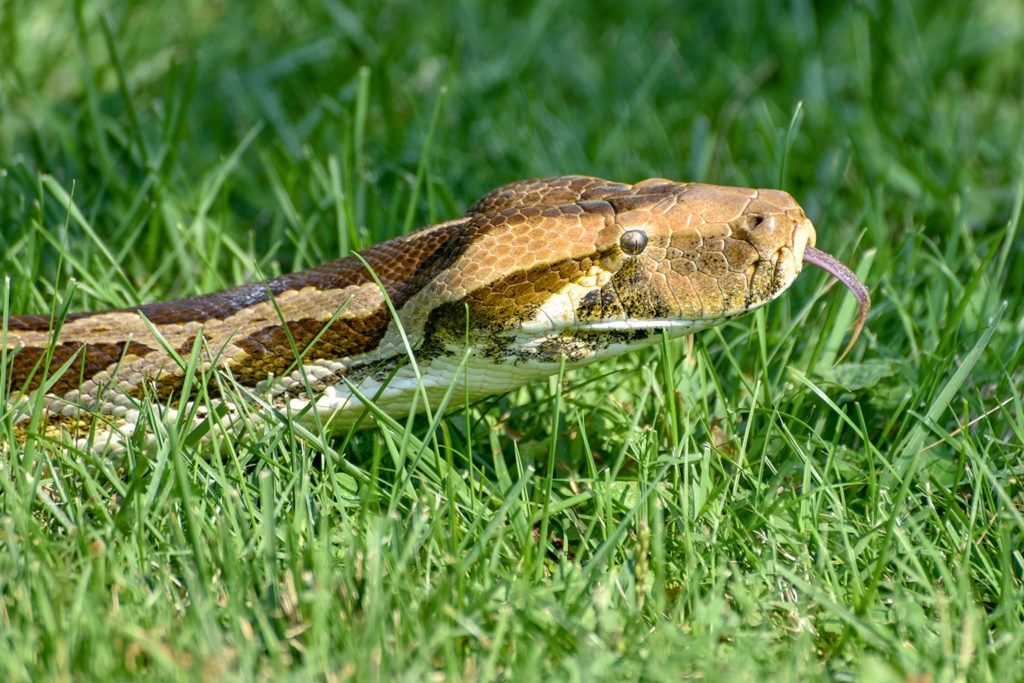Overview
“Where I live”
Indian pythons are native to the dense forests of India, Sri Lanka, Pakistan, and Nepal.
The Maryland Zoo features an Indian python named “Lucy” as one of its most popular and mesmerizing Animal Ambassadors, which are introduced to audiences in education programs on and off grounds.
“How I live there”
An Indian python might be found on the ground or dangling from a tree branch, resting or waiting to ambush prey, camouflaged well by its markings. Like most pythons and boas, these snakes are solitary animals that seek companionship only during breeding season and only from a mate. They are somewhat territorial, preferring to settle in and “claim” a favorite roosting site.
Indian pythons hunt mainly at night, aided by heat-sensing pits in their upper and lower jaws. These organs are highly sensitive to the slightest change in temperature and help pinpoint the location of warm-blooded prey. Indian pythons, like other snakes, also use chemoreception to track prey and investigate their environment. The snake will flick its tongue to gather chemical samples from the atmosphere and deliver them to a special organ in the roof of the mouth – the Jacobson’s organ – where they are analyzed.
Indian pythons, like other pythons and boas, are constrictors. After striking quickly and pulling prey into their mouths, they squeeze it to suffocate and immobilize it and then slowly swallow. Pythons feed mainly on small mammals and birds. They do not require food often, and can go weeks or months between meals.
“Making my mark”
Pythons are the most ancient type of snake. All pythons have spurs – tiny projections where their ancestors might once have had legs.
Raising Young
All pythons are oviparous, which means that they produce eggs (that happen to be leathery-shelled). The female lays her eggs and then encircles them with her coils and lays her head on top to keep them safe and warm. It is unusual for a snake to incubate its eggs, but many pythons do, and Indian python females do so for a period of two to three months.
Baby pythons break out of their egg shells with the help of an egg tooth – a small, sharp projection that falls off shortly after hatching. Once hatched, the young quickly become independent.
“What eats me”
Pythons and boas rely mainly on camouflage to avoid detection by predators. They are very good at staying still or withdrawing from sight in order to avoid detection as well.
Contrary to popular myth, pythons and boas rarely attempt to coil around a would-be predator. Instead, they may discourage an aggressor by inflating their bodies and striking out, acting as intimidating as possible.
Indian pythons have few if any known predators other than man.
Conservation
The Indian python and other python species have long been hunted for their skins, which are made into fashionable accessories, and trapped for the pet trade. People also tend to kill large snakes such as the Indian python out of fear. Additionally, this species of snake is threatened by shrinking habitat caused by deforestation.
Indian pythons are considered a vulnerable species and are now protected, along with other python species, by CITES I, which prohibits trade in live pythons and python products. Poaching is still a major threat, though. India has established many wildlife reserves where Indian pythons are technically protected, but the borders of these reserves are difficult to patrol.
Taxonomy
- Kingdom: Animalia
- Phylum: Chordata
- Subphylum: Vertebrata
- Class: Reptila
- Order: Squamata
- Family: Pythonidae
- Genera: Python
- Species: molurus
What is an Animal Ambassador?
The Maryland Zoo refers to its special collection of education program animals as “Animal Ambassadors.” The Zoo currently cares for more than 60 Animal Ambassadors, representing more than 40 species, both native and exotic. These animals are managed separately from the rest of the Zoo’s collection and cannot be seen on exhibit at the Zoo. However, many can be seen up close and personal on a rotating basis at Creature Encounters, the Zoo’s outdoor education center; at camp and school programs at the Zoo; as featured participants in community-based Outreach programs; and at special events on and off Zoo grounds.
Animal Ambassadors spend countless hours working with their human handlers, developing bonds of trust and communication that will allow them to appear in front of audiences large and small. They are not show animals. They behave naturally, focusing audiences’ attention on their natural behaviors and adaptations and giving living, breathing meaning to concepts and topics that students may be studying.
Animal Ambassadors travel all over the state of Maryland and beyond, and many also make local and national media appearances, educating about wildlife while representing the Zoo and its commitments to animal welfare and conservation.
What is The Animal Embassy?
The Animal Embassy at The Maryland Zoo is an off-exhibit area that is not open to the public. It is where the Zoo’s “Animal Ambassadors,” or education program animals, live. The Embassy is home to more than 60 individual animals representing more than 40 different species. It is staffed by its own dedicated group of keepers and volunteers and has both indoor and outdoor living space for the animals.


